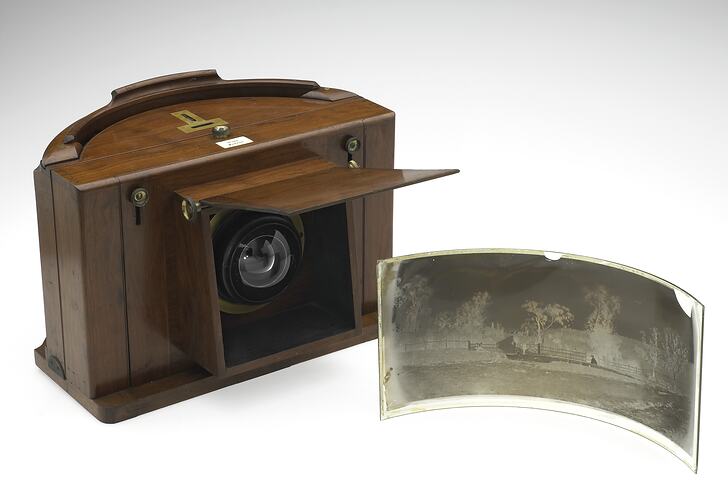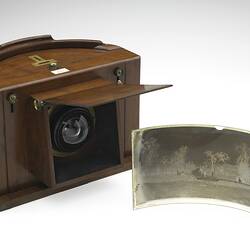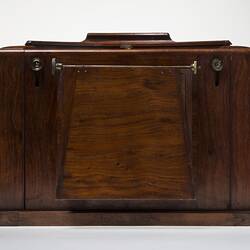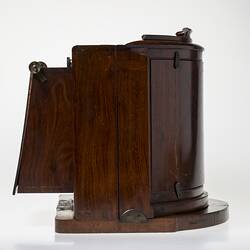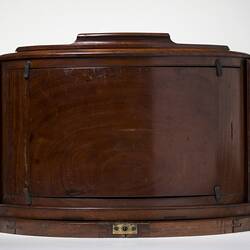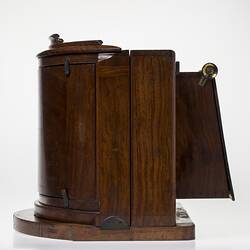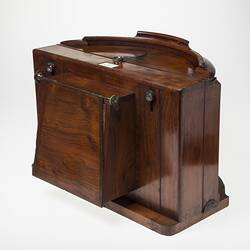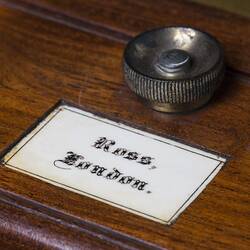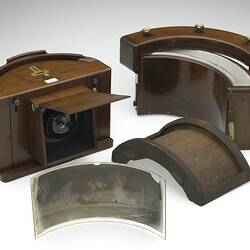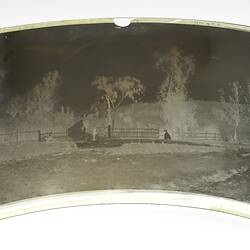Summary
Sutton panoramic camera body with 76 mm lens protected by a hinged wooden flap. This camera was used by Richard Daintree in Victorian Land Survey of 1864.
The lens was designed by Thomas Sutton (1819-75) of St. Brelade, Island of Jersey, in 1859. The camera consists of a curved wooden back, designed to take curved glass wet-plate negatives. The large curved plate coupled with the wide angled lens, produced panoramic photographs. Sutton's achromatic panoramic lens fitted to this camera was the earliest panoramic wide-angle lens ever produced and patented by Sutton on the 28th September, 1859 (patent no. 2193). It consists of a globular sheet of flint glass filled with filtered distilled water when in use, and divided into two equal compartments by a brass diaphragm. The angle of field is 140 degrees. Includes curved vessel for sensitising the plate, curved printing frame and a curved wooden plate holder. The camera was manufactured by Thomas Ross, London, U.K. around 1861.
The blank plate was dipped in emulsion in the sensitising tank and the photograph was taken while the plate was still wet. The museum also holds 12 curved glass negatives taken by Richard Daintree, a pioneer of Australian fieldwork photography, using this camera.
Physical Description
Main body of Sutton panoramic camera, which is essentially a varnished wooden box with a curved back and incorporating a domed glass lens. The main body includes the wooden base plate, a hinged wooden lens box and cover with a brass hinge and knobs, and two wooden frames. The distance between the front frame and the second can be altered by turning brass screws; the screw at the centre back of the base plate is missing. Two glass 'levels' are inset into a brass plate on the top surface of the second frame. The interior of the main body is painted black. When compared to ST 15479 it would appear the internal half of the lens is missing
More Information
-
Collecting Areas
-
Acquisition Information
Donation from Victoria: Crown Lands & Survey Department, 1977
-
Inventor
-
Manufacturer
-
Used By
-
Inscriptions
Lettered in black on a white (ivory?) plate on top surface: Ross, / London Registration number lettered in white ink on brass plate at centre rear.
-
Classification
-
Category
-
Discipline
-
Type of item
-
Overall Dimensions - Open
367 mm (Width), 300 mm (Depth), 391 mm (Height)
Lens flap fully open
-
Overall Dimensions - Closed
367 mm (Width), 300 mm (Depth), 245 mm (Height)
Lens flap closed and including brass knob on top surface.
-
Other Dimensions
165 mm (Length)
Internal measurement - distance from centre of front face (underneath lens opening) to centre back of curved lip, when the two frames are abutted.
-
Other Dimensions
90 mm (Outside Diameter)
Internal measurement - diameter of metal lens fitting.
-
Other Dimensions
171 mm (Width), 82 mm (Depth), 173 mm (Height)
Measurements of lens box, excluding brass knobs. Depth given is maximum depth (deeper at bottom).
-
Keywords
Cameras, Camera Accessories, Camera Components, Camera Lenses, Negatives
